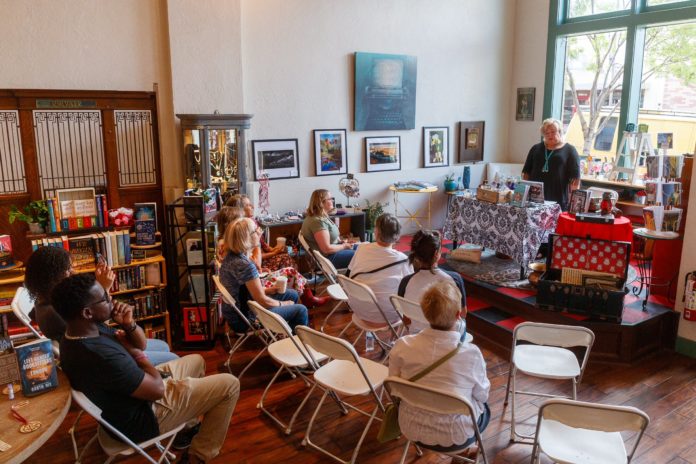Local author Peggy Hicks truly enjoys her work.
While reading from her latest book, “Bootleggers, Bottles & Badges: The More Sinister Side of the So-called “Model Town” of Clarkdale Arizona,” Hicks brought her stories to life using a trunk-full of props: Authentic antique bottles, newspaper clippings, a pistol, and an old spittoon, which she literally kicked off the stage, intentionally during her performance at Stardust Books on Saturday, July 16.
For about an hour, Hicks told stories — some true, others folklore — of Clarkdale’s history and colorful cast of characters who lived during the time of prohibition from about 1915 to 1930.
While donning several hats, a veil and even the classic nose and glasses disguise, Hicks transformed herself, becoming the book’s characters, including the town’s founder, William A. Clark.
While wearing a top hat, Hicks revealed the more “sinister” side of Clark, including a “dishonest” campaign to become a senator in 1899.
“It was reported that he bribed his voters with $1,000 bills, spending more than $430,000 to become a senator of Montana,” she said. “When Clark was confronted for his bribery, he said, ‘I have never bought a man that wasn’t for sale.’”
According to senate.gov, “The senate referred the matter to the Committee on Privileges and Elections, which quickly asked for and received authorization to conduct a full investigation into Clark’s election. On April 23, 1900, after hearing extensive testimony from 96 witnesses, the committee returned a report unanimously concluding that William Clark was not entitled to his seat. The testimony detailed a dazzling list of bribes ranging from $240 to $100,000. In a high-pressure, well-organized scheme coordinated by Clark’s son, Clark’s agents had paid mortgages, purchased ranches, paid debts, financed banks and blatantly presented envelopes of cash to legislators.”
State legislatures elected senators before the 17th Amendment made them directly elected by voters in 1913.
Despite resigning before the senate committee could vote him down from his seat, Clark eventually became senator anyway, after Montana’s acting governor appointed him to fill a vacant seat.
The following year, he was elected to the senate by “a newly elected Montana legislature — in which most of the winning candidates had received financial support from [Clark].”
“Clark was a merchant, a miner and a millionaire by the time he was 30 years old,” Hicks said. “In 1910 he started buying up property at the bottom of Mingus Mountain, where he would build a smelter. Then he built a railroad along the Verde River, where he used the train to take copper out to market.”
Hicks told stories about the town’s booming business and growth fueled by the mines, which emitted toxic smoke and fumes and killed the vegetation in the surrounding areas.
Hicks said that while most mining towns of the era grew haphazardly in an uncontrolled fashion, Clark’s vision for the town of Clarkdale was different, and it went on to become Arizona’s first master-plan town.
Hicks’ interest in history has led her to author a total of four books, including ‘Bootleggers.’ Her other three books include “Ghost Town Stories and Wicked Legends, Are Ghosts Real?” “The Story of Belgian Jennie: The Richest Madam in the Arizona Territory” and “The Ghost of the Cuban Queen Bordello: A Story of a 1920’s Jerome Madam.”
After operating her retail store in Jerome for 25 years, Hicks relocated to Clarkdale.
“I have lived in Clarkdale for 30 years,” she said. “Clarkdale was supposed to be the model town and so I didn’t think there would be much history, until I started looking into the archives and doing research, and after finding antique bottles of medicine, liquor and more, I began to wonder what they were used for and who sold them and the whole thing kind of came together.”
Hicks’ bottle collection includes old liquor and milk bottles, “snake oil” medicines and others, which she says that she acquired from various dumps around town.
“I’ve dug for bottles for years,” she said. “I used to live in Colorado and go to Telluride and stuff like that. To me, it’s amazing how they worked; they used molds, the first bottles were blown glass.”
Throughout her reading, Hicks used the bottles as props as she told stories of old pharmacies, bootlegging operations and more.
“I’ve always just loved history,” she said. “My grandmother was a storyteller, and I picked up my love of [storytelling] from her.”
Hicks said she sells her books locally, in Jerome and at the Verde Canyon Railroad in Clarkdale, but most of her sales are online through Amazon, where she has self-published her works.



